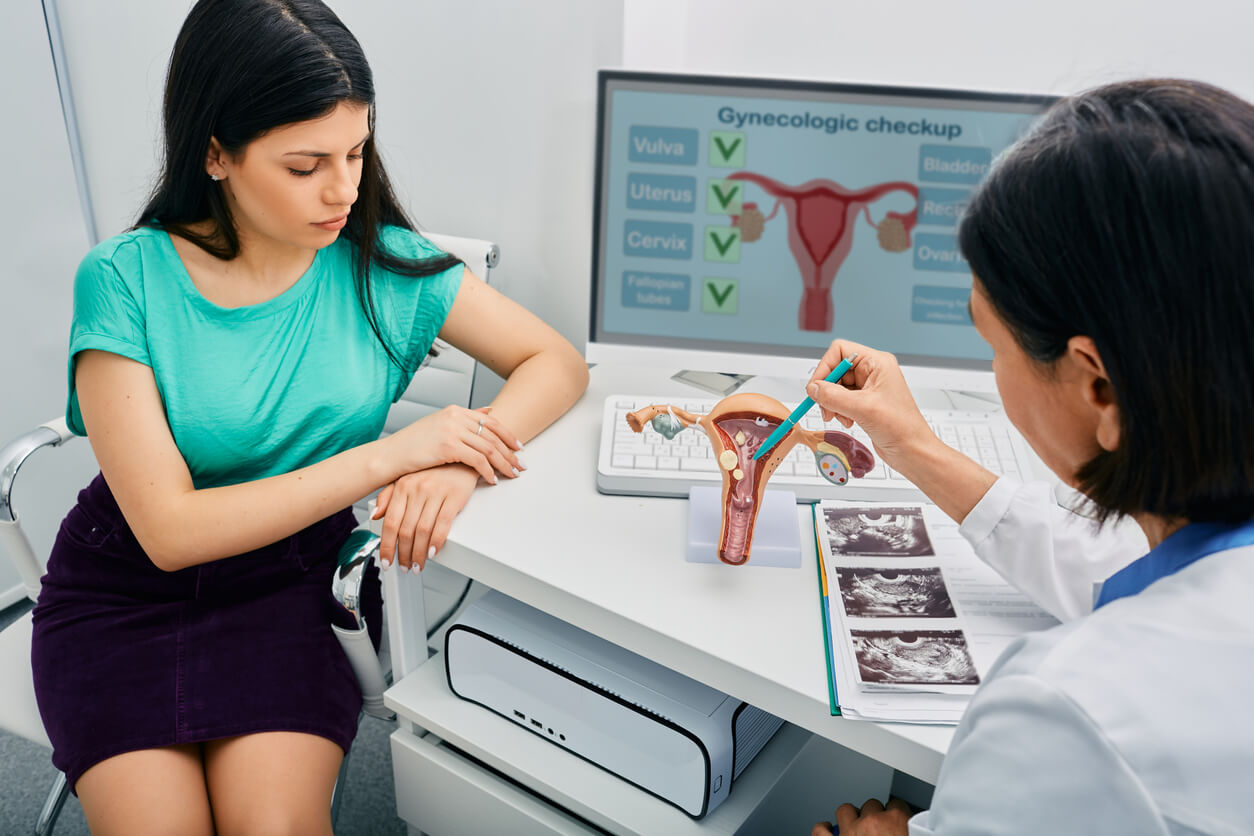Vaginal Infections During Pregnancy: Prevention and Treatment


Written and verified by the nurse Leidy Mora Molina
Vaginal infections during pregnancy can arise due to certain factors that predispose the mother to suffer them. These have the particularity that they can be very serious for the pregnancy if they’re not treated in time. Do you want to know more about this topic? Keep reading!
These infections are also known as vaginitis or vulvovaginitis and affect the external part of the reproductive system. In this way, they cause inflammation and irritation of its walls. Vaginitis can be caused by chemical substances that stimulate a tissue reaction or by the invasion of pathogenic microorganisms such as bacteria, fungi, or viruses. Bacterial vaginosis and vaginal candidiasis are the most frequent infections at this stage.
On the other hand, we must emphasize that the baby is protected inside the uterus and separated from the vaginal canal by the mucous plug. This prevents the baby from coming into contact with bacteria or other microorganisms found in the area. However, if vaginal infections aren’t treated promptly, they can invade nearby tissues and bring undesirable consequences in pregnancy.
Causes of vaginal infections during pregnancy
During pregnancy, our body temporarily modifies certain functions in order to allow the well-being of the baby inside the uterus. One of the tissues affected is the vaginal canal. This occurs because, at this stage, there’s an alteration in the natural chemical balance of the vagina, as a consequence of hormonal action. This has a direct impact on the vaginal flora and the pH of the area, which causes the acidity to drop and microorganisms to enter.
In this regard, the vaginal flora, that is, the good bacteria that serve as protection, are affected and don’t perform their functions effectively. As a result, there’s a decrease in the number of protectors in the vagina, which increases exposure to viruses, fungi, and bacteria.
In addition, hormonal activity also causes the mother to experience changes in her immune system. As a result, there’s a decrease in her defenses to prevent maternal-fetal rejection, increasing the risk of infections.

Symptoms and risks
The symptoms of vaginal infections depend on the pathogen that causes it and the degree of infection it has. In other words, the manifestations of bacterial vaginosis aren’t the same as those of a yeast infection. Among the common symptoms of vaginal infections, we can find the following:
- Itching in the genital area.
- Abundant vaginal discharge. Sometimes it may turn yellow or greenish and develop an odor and its consistency may become thicker.
- Vaginal irritation.
- Slight vaginal bleeding may occur.
- Pain or burning when urinating.
- Pain during sexual intercourse.
Treatment of vaginal infections
Treatment of vaginal infections during pregnancy should take place as soon as possible because the consequences they can bring are serious. For example, they can stimulate contractions and thus accelerate premature labor. In addition, they can cause the following:
- Premature rupture of membranes
- Miscarriages
- Low birth weight
- Endometritis

How to prevent vaginal infections during pregnancy
However, it’s important to know that vaginitis can be avoided. Just by carrying out a series of daily care practices to keep the intimate area in proper condition may be enough. Let’s take a look at some tips:
- Use neutral pH soaps for vaginal washing. Avoid those that are strong and smelly, as well as those that may be irritating to the area.
- Avoid constant washing and douching. This alters the vaginal flora and the pH of the area, which is necessary for the elimination of harmful agents.
- If you use panty liners, choose good quality, odorless ones. You should change them at least 4 times a day.
- Use cotton underwear. Avoid tight clothing, especially pants, as they can cause irritation and inflammation in the genital area.
- Dry the vulva very well after bathing, as humidity favors the colonization of microorganisms.
- Cleaning the area after defecation should be done from front to back, so as not to drag the bacteria present in the feces to the vulva.
- Wash intimate apparel with neutral soap or mild, unscented soap.
- Avoid perfumed intimate hygiene products, such as sprays and deodorants.
- If you swim, it’s important to change your swimsuit for a dry one when you get out of the water to avoid exposure to moisture.
- Use condoms during sexual intercourse in case of suspected vaginitis. This is a barrier method to avoid transmission or re-infection.
- Include yogurt with Lactobacillus in your diet, as several studies recommend it in order to prevent vaginal infections.
Incorporate healthy habits and consult with your doctor
If you follow these recommendations, you’ll prevent the proliferation of microorganisms in the intimate area. Of course, this must become a habit and be accompanied by a good diet. Keep in mind that nutrients from the daily diet can help strengthen the immune system.
If you have any concerns about the subject or if you begin to have any of the symptoms described above, you should consult your doctor immediately. They’ll make an evaluation and you should follow their instructions strictly.
Vaginal infections during pregnancy can arise due to certain factors that predispose the mother to suffer them. These have the particularity that they can be very serious for the pregnancy if they’re not treated in time. Do you want to know more about this topic? Keep reading!
These infections are also known as vaginitis or vulvovaginitis and affect the external part of the reproductive system. In this way, they cause inflammation and irritation of its walls. Vaginitis can be caused by chemical substances that stimulate a tissue reaction or by the invasion of pathogenic microorganisms such as bacteria, fungi, or viruses. Bacterial vaginosis and vaginal candidiasis are the most frequent infections at this stage.
On the other hand, we must emphasize that the baby is protected inside the uterus and separated from the vaginal canal by the mucous plug. This prevents the baby from coming into contact with bacteria or other microorganisms found in the area. However, if vaginal infections aren’t treated promptly, they can invade nearby tissues and bring undesirable consequences in pregnancy.
Causes of vaginal infections during pregnancy
During pregnancy, our body temporarily modifies certain functions in order to allow the well-being of the baby inside the uterus. One of the tissues affected is the vaginal canal. This occurs because, at this stage, there’s an alteration in the natural chemical balance of the vagina, as a consequence of hormonal action. This has a direct impact on the vaginal flora and the pH of the area, which causes the acidity to drop and microorganisms to enter.
In this regard, the vaginal flora, that is, the good bacteria that serve as protection, are affected and don’t perform their functions effectively. As a result, there’s a decrease in the number of protectors in the vagina, which increases exposure to viruses, fungi, and bacteria.
In addition, hormonal activity also causes the mother to experience changes in her immune system. As a result, there’s a decrease in her defenses to prevent maternal-fetal rejection, increasing the risk of infections.

Symptoms and risks
The symptoms of vaginal infections depend on the pathogen that causes it and the degree of infection it has. In other words, the manifestations of bacterial vaginosis aren’t the same as those of a yeast infection. Among the common symptoms of vaginal infections, we can find the following:
- Itching in the genital area.
- Abundant vaginal discharge. Sometimes it may turn yellow or greenish and develop an odor and its consistency may become thicker.
- Vaginal irritation.
- Slight vaginal bleeding may occur.
- Pain or burning when urinating.
- Pain during sexual intercourse.
Treatment of vaginal infections
Treatment of vaginal infections during pregnancy should take place as soon as possible because the consequences they can bring are serious. For example, they can stimulate contractions and thus accelerate premature labor. In addition, they can cause the following:
- Premature rupture of membranes
- Miscarriages
- Low birth weight
- Endometritis

How to prevent vaginal infections during pregnancy
However, it’s important to know that vaginitis can be avoided. Just by carrying out a series of daily care practices to keep the intimate area in proper condition may be enough. Let’s take a look at some tips:
- Use neutral pH soaps for vaginal washing. Avoid those that are strong and smelly, as well as those that may be irritating to the area.
- Avoid constant washing and douching. This alters the vaginal flora and the pH of the area, which is necessary for the elimination of harmful agents.
- If you use panty liners, choose good quality, odorless ones. You should change them at least 4 times a day.
- Use cotton underwear. Avoid tight clothing, especially pants, as they can cause irritation and inflammation in the genital area.
- Dry the vulva very well after bathing, as humidity favors the colonization of microorganisms.
- Cleaning the area after defecation should be done from front to back, so as not to drag the bacteria present in the feces to the vulva.
- Wash intimate apparel with neutral soap or mild, unscented soap.
- Avoid perfumed intimate hygiene products, such as sprays and deodorants.
- If you swim, it’s important to change your swimsuit for a dry one when you get out of the water to avoid exposure to moisture.
- Use condoms during sexual intercourse in case of suspected vaginitis. This is a barrier method to avoid transmission or re-infection.
- Include yogurt with Lactobacillus in your diet, as several studies recommend it in order to prevent vaginal infections.
Incorporate healthy habits and consult with your doctor
If you follow these recommendations, you’ll prevent the proliferation of microorganisms in the intimate area. Of course, this must become a habit and be accompanied by a good diet. Keep in mind that nutrients from the daily diet can help strengthen the immune system.
If you have any concerns about the subject or if you begin to have any of the symptoms described above, you should consult your doctor immediately. They’ll make an evaluation and you should follow their instructions strictly.
All cited sources were thoroughly reviewed by our team to ensure their quality, reliability, currency, and validity. The bibliography of this article was considered reliable and of academic or scientific accuracy.
- Brot, C. (2019). Infecciones cervicovaginales durante el embarazo: recomendaciones. EMC – Ginecología-Obstetricia Volume 55, Issue 1, February 2019, Pages 1-11.
- Pradenas, M (2014). Infecciones cérvico vaginales y embarazo. Revista médica los condes. Tema central: Obstetricia y ginecología Vol. 25. Núm. 6. Páginas 925-935. (Noviembre 2014)
- Ferreres, I. (2008). El pH vaginal en el embarazo. Revista matronas profesión; 9 (4): 18-20. Recuperado de: https://www.federacion-matronas.org/revista/wp-content/uploads/2018/01/vol9n4pag18-20.pdf
This text is provided for informational purposes only and does not replace consultation with a professional. If in doubt, consult your specialist.








